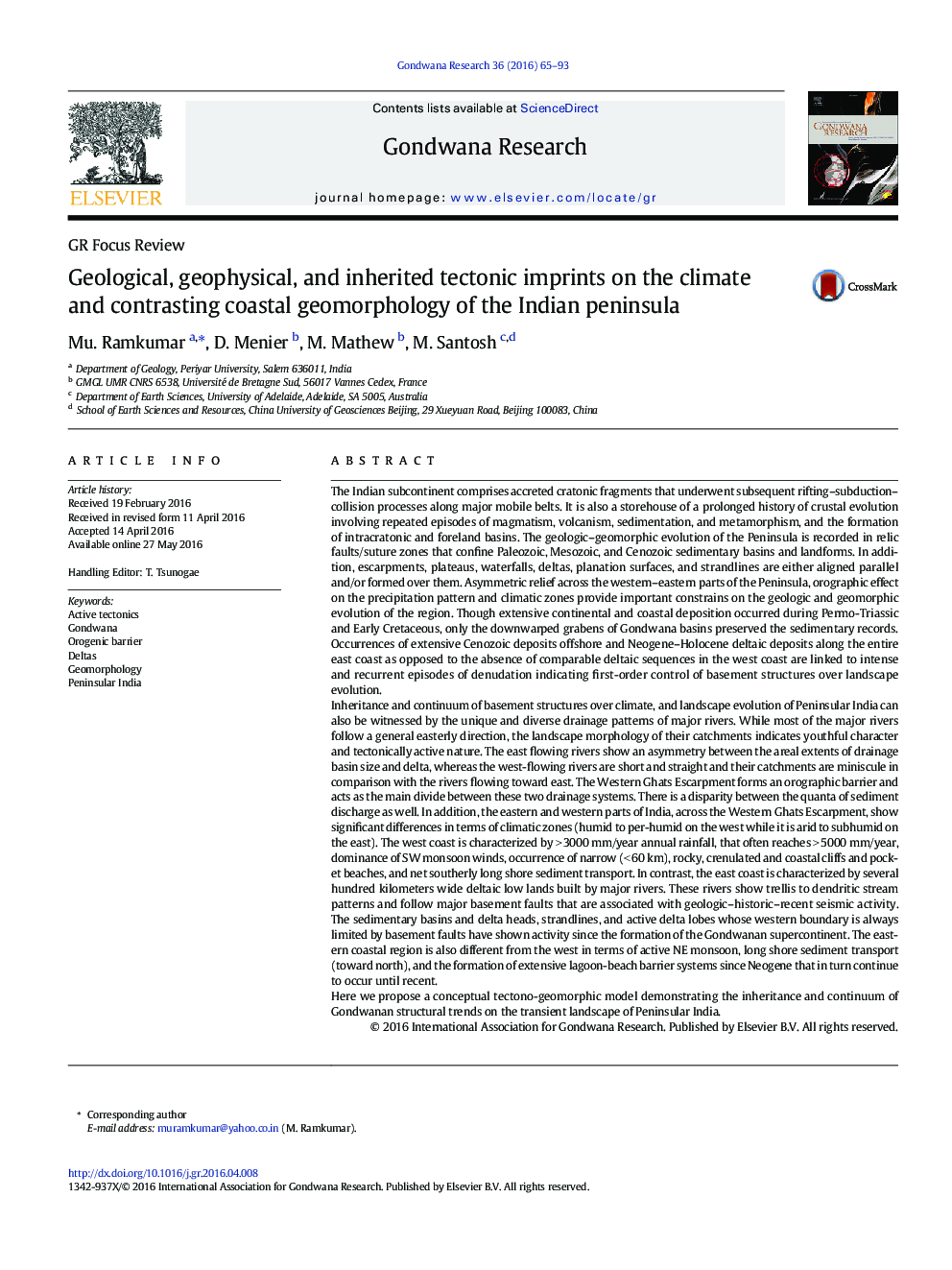| کد مقاله | کد نشریه | سال انتشار | مقاله انگلیسی | نسخه تمام متن |
|---|---|---|---|---|
| 4726620 | 1640135 | 2016 | 29 صفحه PDF | دانلود رایگان |

• Geological–geomorphic evolution of Indian Peninsula.
• Sedimentary basins and delta heads, and delta lobes were active since the formation of the Gondwana.
• Model of inheritance and continuum of Gondwanan structural trends.
The Indian subcontinent comprises accreted cratonic fragments that underwent subsequent rifting–subduction–collision processes along major mobile belts. It is also a storehouse of a prolonged history of crustal evolution involving repeated episodes of magmatism, volcanism, sedimentation, and metamorphism, and the formation of intracratonic and foreland basins. The geologic–geomorphic evolution of the Peninsula is recorded in relic faults/suture zones that confine Paleozoic, Mesozoic, and Cenozoic sedimentary basins and landforms. In addition, escarpments, plateaus, waterfalls, deltas, planation surfaces, and strandlines are either aligned parallel and/or formed over them. Asymmetric relief across the western–eastern parts of the Peninsula, orographic effect on the precipitation pattern and climatic zones provide important constrains on the geologic and geomorphic evolution of the region. Though extensive continental and coastal deposition occurred during Permo-Triassic and Early Cretaceous, only the downwarped grabens of Gondwana basins preserved the sedimentary records. Occurrences of extensive Cenozoic deposits offshore and Neogene–Holocene deltaic deposits along the entire east coast as opposed to the absence of comparable deltaic sequences in the west coast are linked to intense and recurrent episodes of denudation indicating first-order control of basement structures over landscape evolution.Inheritance and continuum of basement structures over climate, and landscape evolution of Peninsular India can also be witnessed by the unique and diverse drainage patterns of major rivers. While most of the major rivers follow a general easterly direction, the landscape morphology of their catchments indicates youthful character and tectonically active nature. The east flowing rivers show an asymmetry between the areal extents of drainage basin size and delta, whereas the west-flowing rivers are short and straight and their catchments are miniscule in comparison with the rivers flowing toward east. The Western Ghats Escarpment forms an orographic barrier and acts as the main divide between these two drainage systems. There is a disparity between the quanta of sediment discharge as well. In addition, the eastern and western parts of India, across the Western Ghats Escarpment, show significant differences in terms of climatic zones (humid to per-humid on the west while it is arid to subhumid on the east). The west coast is characterized by > 3000 mm/year annual rainfall, that often reaches > 5000 mm/year, dominance of SW monsoon winds, occurrence of narrow (< 60 km), rocky, crenulated and coastal cliffs and pocket beaches, and net southerly long shore sediment transport. In contrast, the east coast is characterized by several hundred kilometers wide deltaic low lands built by major rivers. These rivers show trellis to dendritic stream patterns and follow major basement faults that are associated with geologic–historic–recent seismic activity. The sedimentary basins and delta heads, strandlines, and active delta lobes whose western boundary is always limited by basement faults have shown activity since the formation of the Gondwanan supercontinent. The eastern coastal region is also different from the west in terms of active NE monsoon, long shore sediment transport (toward north), and the formation of extensive lagoon-beach barrier systems since Neogene that in turn continue to occur until recent.Here we propose a conceptual tectono-geomorphic model demonstrating the inheritance and continuum of Gondwanan structural trends on the transient landscape of Peninsular India.
Figure optionsDownload as PowerPoint slide
Journal: Gondwana Research - Volume 36, August 2016, Pages 65–93